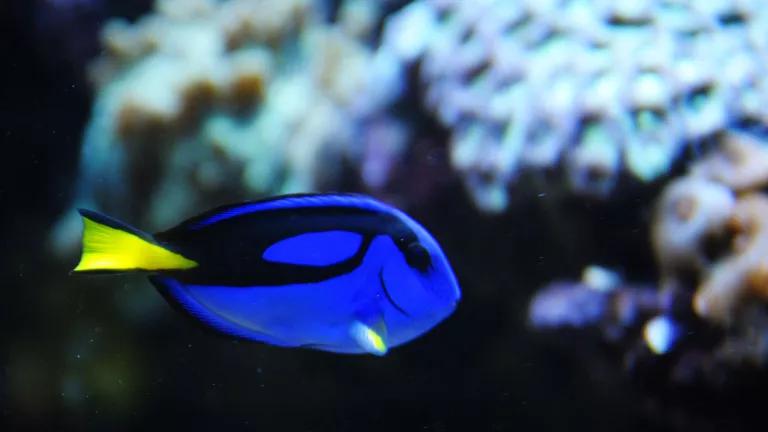How About We Just Leave Dory Alone?
Sales of clown fish skyrocketed after "Saving Nemo." Will the same happen for blue tangs after the release of "Finding Dory"?

It’s been more than a decade since Disney released its smash hit Finding Nemo—a delightful animated tale about a father clown fish trying to rescue his son from the pet trade. But the moral of the story seems to have been lost on many viewers: Clown fish sales skyrocketed after the film’s debut, and even today, some one million clown fish are captured from the wild each year to supply the aquarium industry.
Well, guess what? This weekend, Disney will release a sequel, titled Finding Dory, and some experts are worried there may soon be a clown fish–like run on the new film’s title species, the royal blue tang. “I don’t think there’s a day that goes by where I haven’t been asked if we have Dory on display here,” says Becky Ellsworth, assistant curator at the Columbus Zoo and Aquarium in Ohio. And that’s been happening since the first movie.
But potential buyers should beware—beta fish these are not.
Caring for a royal blue tang, also known as a palette surgeonfish or regal blue tang, is next-level animal husbandry. Native to reefs of the Indo-Pacific, the fish require expensive, complicated saltwater tank ecosystems that may as well require a master’s degree to operate. They can also impale you with a dagger-like spike by their tailfin. (Though I guess if you’re trying to handle your blue tang, you might deserve a good impaling.)
Oh, and one more thing, the blue tang can live up to 20 years. Which means if you manage to keep your Dory alive at all, you could be performing round-the-clock tank maintenance for approximately 19.5 years after your child is bored with it.
Good luck with that, especially since not even zoos have figured out how to breed this species in captivity, Ellsworth says. That means every single blue tang you see in a pet store or a fancy restaurant aquarium will have been sourced from the wild, specifically the Indo-Pacific—which sort of has a reputation for unsustainable fish-catching practices, such as using cyanide spray.
Unscrupulous divers can use a cyanide spray to stun the fish and make them loopy. Many fish simply die on contact, while others expire en route to the pet store. Still more die within hours of being purchased and introduced to their new homes, whether from the cyanide or from receiving inadequate care.
And that’s not even the end of it. Blue tangs are best buds with coral. They eat the plankton and algae that accumulates on the coral and use its branches for protection. But when a poacher squirts a cyanide cloud into a crevice to capture a Dory, up to a square yard of coral may die off in the process. Even lower doses can lead to coral bleaching, upending an entire ecosystem just so someone can have a pet.
Using cyanide is super illegal. “But it’s definitely hard to police, as you might imagine, because it happens underwater,” Ellsworth says. Worst of all, a 2008 report from the National Oceanic and Atmospheric Association found that up to 90 percent of the tropical fish imported into the United States each year are caught using cyanide.
Are you starting to see why a renewed interest in tropical fish could be worrisome?
While the blue tang is currently listed under the International Union for Conservation of Nature's Least Concern category, we should be careful about such classifications. The amount of study this species has received thus far is not nearly sufficient for the potential strain it's about to see, if the post-Dory market is anything like it was post-Nemo.
The good news is, any popular depiction of a wild animal usually also brings with it increased education and awareness. A Disney spokesperson told the Orlando Sentinel that the company's conservationists are working with the Association of Zoos and Aquariums on a program to support tang conservation. The company also said it is preparing educational materials discouraging personal ownership of blue tangs.
Ellsworth says, “I think we are raising a generation of future conservationists, kids who are growing up with more knowledge than we ever had.” Even in Columbus, Ohio, a city nowhere near an ocean, much less a coral reef, Ellsworth is always hearing from kids who want to be marine biologists. And she attributes movies like Finding Nemo with sparking that interest.
But it’s up to us adults to make sure we’re setting the right example by explaining where animals in the pet trade come from and by working to make sure we’re only supporting sustainable fisheries—whether they’re destined for fishbowls or our plates.
This article was originally published on onEarth, which is no longer in publication. onEarth was founded in 1979 as the Amicus Journal, an independent magazine of thought and opinion on the environment. All opinions expressed are those of the authors and do not necessarily reflect the policies or positions of NRDC. This article is available for online republication by news media outlets or nonprofits under these conditions: The writer(s) must be credited with a byline; you must note prominently that the article was originally published by NRDC.org and link to the original; the article cannot be edited (beyond simple things such grammar); you can’t resell the article in any form or grant republishing rights to other outlets; you can’t republish our material wholesale or automatically—you need to select articles individually; you can’t republish the photos or graphics on our site without specific permission; you should drop us a note to let us know when you’ve used one of our articles.

How to Become a Community Scientist
Biodiversity 101
How to Start Saving the Planet in 100 Days: the Joe Biden Edition